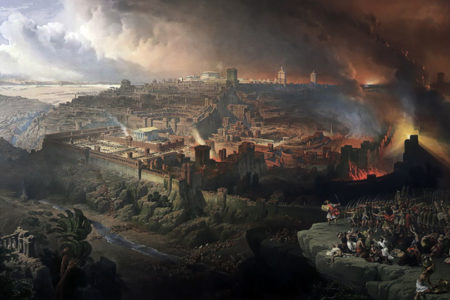The Timing of the Second Coming of Christ: Its Practical Implications: Matthew 24:32–51
The Parable of the Fig Tree (vv. 32–36)
After Christ foretold events of the Tribulation period and His Second Coming in His Matthew 24 discourse, He taught the parable of the fig tree:
Now learn a parable of the fig tree: When its branch is yet tender, and putteth forth leaves, ye know that summer is near; So likewise ye, when ye shall see all these things, know that it is near, even at the doors. Verily I say unto you, This generation shall not pass, till all these things be fulfilled (vv. 32–34).
In light of the immediate context, it seems obvious that Jesus taught this parable to explain the timing of His Second Coming, when He will establish the future Kingdom of God (cp. Lk. 21:29–32). But what exactly was He saying through this parable?
A number of fine Christians believe that Christ used the fig tree to represent the nation of Israel, that the time when the tree’s branch is tender and it puts forth leaves refers to Israel’s restoration as an independent nation in 1948, and that the expression all these things (v. 33) also refers to that restoration. On the basis of this theory, they conclude that Jesus was saying, through this parable, that the restoration of Israel as a nation in 1948 would be a sign that His Second Coming was near and would take place within the lifetime of the generation that would witness that restoration. As a result, some people have set specific dates for the return of Christ, and others have asserted that He must return within a few decades after 1948.
There are at least two problems with this understanding of the parable. First, in the expanded version, recorded in Luke 21:29–32, Jesus talked about the fig tree “and all the trees” and the time when “they” shoot forth leaves. If Christ were using the fig tree to represent Israel, what do all the other trees represent? Also, if the time of the fig tree putting forth its leaves referred to Israel’s restoration as a nation in 1948, to what did the shooting forth of leaves by all the other trees refer?
Second, the expression all these things in Matthew 24:33 indicates more than one event. It cannot refer to Israel’s 1948 restoration because that restoration was one event.
In light of these two problems, it appears that Christ did not use the fig tree to refer to Israel but as an illustration from nature: The time of the tree’s branch being tender and its putting forth of leaves is a time in nature’s yearly cycle. The expression all these things does not refer to Israel’s restoration but to all the events (i.e., famines, pestilences, earthquakes, the abomination of desolation, and the Great Tribulation) that will occur in the Tribulation period and to which Christ referred earlier in this discourse.
These references prompt the conclusion that Christ was instructing them through the parable of the fig tree to learn a lesson from nature. Just as it is known that summer is near when the fig tree has a tender branch and puts forth its leaves, so it will be known that His coming to establish the future Kingdom of God is near when all the events of the Tribulation to which He referred earlier are seen by the world. His coming will take place during the lifetime of the generation that will witness all these events of the Tribulation period. To that generation Jesus said, “Heaven and earth shall pass away, but my words shall not pass away” (v. 35).
Then Jesus asserted that even though people will be able to know that they are in that time period, it will not be possible for them to know the precise day or hour of His coming because “of that day and hour knoweth no man, no, not the angels of heaven, but my Father only” (v. 36).
The Parallel with the Days of Noah (vv. 37–41)
Jesus taught that the order of events at His Second Coming will be parallel to the order of events in the days of Noah. During the days that Noah gave his forewarnings of coming judgment, the unsaved devoted their full attention to the normal activities of daily life and did not prepare for the coming judgment by turning to God for salvation. Because the unsaved did not know the precise day on which the judgment would begin, they did not know the specific time by which they must be prepared. As a result, the day of judgment came so suddenly that they had no time to make ready for it and were totally unprepared to escape God’s judgment. The flood took all the unsaved away in judgment, but it left the saved (Noah and his family) alive on the earth to enter the next period of world history.
Jesus said, “so shall also the coming of the Son of man be” (v. 37). In spite of the Tribulation period’s forewarning signs of Christ’s coming in judgment, the unsaved will devote their full attention to the normal activities of life and will not prepare for the coming judgment by accepting Jesus as their Savior. Because no one will know the precise day or hour of Christ’s coming, the unsaved will not know the specific time by which they must be prepared. As a result, Christ will come so suddenly that they will have no time to prepare. They will not be able to escape the judgment. At Christ’s Second Coming all the unsaved will be taken from the earth in judgment, but the living Tribulation saints will be left on the earth to enter the next period of world history, the Millennium. It will be in the same order as the flood in the days of Noah.
The ones taken from the field and the mill (vv. 40–41) are the unsaved, who will be removed in judgment when Christ returns after the Tribulation. The ones left in the field and at the mill when He returns are the saved, who will enter the future Kingdom of God. Luke’s record of this same teaching by Christ substantiates this understanding, for it indicates that the bodies of those taken from the field and mill will be eaten by flesh-eating fowl (Lk. 17:34–37). Jesus also taught the same order in his parables of the tares and the dragnet (Mt. 13:24–30, 36–43, 47–50).
It should be noted that the order of events at the Second Coming of Christ after the Tribulation will be the reverse of the order of events at the Rapture of the church, when the saved will be taken from the earth to meet the Lord in the air and the unsaved will be left on the earth (Jn. 14:2–3; 1 Th. 4:13–18). Thus, Jesus was not referring to the Rapture of the church in His Matthew 24 discourse.
Some who object to this interpretation point out that the word translated took in connection with the flood (v. 39) is different from the word translated shall be taken for the removal of people from the field and mill at the Second Coming (vv. 40–41). The latter phrase refers to Jesus receiving saints to Himself in the Rapture of the church (Jn. 14:3). In light of this, they conclude that the first word refers negatively to taking the unsaved in judgment by the flood, but the latter phrase refers positively to taking saints from the field and mill at the Rapture of the church.
However, two things should be observed. First, the latter phrase is also used in a negative sense in the Bible. For example, it was used when the Devil took Jesus to tempt Him (Mt. 4:5, 8) and when Jesus was taken to be crucified (Jn. 19:16). Second, there is a reason for the different words in Matthew 24. God used an impersonal substance (water) to take the unsaved of Noah’s day in judgment, but at Christ’s Second Coming personal beings (angels) will take the unsaved from the field and mill and cast them into their place of judgment (Mt. 13:40–42, 47–50).
The Practical Implications of Jesus’ Teaching (vv. 42–44)
Christ presented two practical implications of His teaching for the people of the Tribulation period. Because they will know with certainty that they are in the time period immediately preceding Christ’s Second Coming and that their generation will not pass away before His coming but they will not know the precise day or hour of His coming, they should do two things: watch, or be on the alert continuously (present tense), for Christ’s Second Coming (v. 42) and be ready, or prepared for it, by accepting Jesus as their Savior (v. 44).
Two Parables Illustrating the Practical Implications (vv. 43, 45–51)
Jesus gave two parables to illustrate the practical implications of His teaching. The first was the parable of the watchful, prepared homeowner (v. 43). A homeowner who knows the time period but not the precise hour in which a thief will come to rob his house will watch and be prepared to prevent the thief from breaking into his house. Likewise, the people of the Tribulation period, because they will know that they are in the time period immediately before Christ’s coming but will not know the precise hour of that coming, should watch and be prepared for His coming by accepting the Savior.
The second parable tells of two contrasting servants (vv. 45–51). A faithful, wise servant is always prepared for the coming of his master and therefore will be rewarded for that preparedness by the master when he comes. Likewise, those who become saved during the Tribulation period will be prepared for the Second Coming of Christ and will be rewarded for that preparedness with the privilege of entering into the blessing of the Millennial Kingdom (cp. Mt. 8:10–11; 13:43; 25:34).
In contrast, an unfaithful, evil servant will not be prepared for the coming of his master and therefore will be judged severely for that unpreparedness by the master when he comes. Likewise, those who do not become saved during the Tribulation period will not be prepared for the Second Coming of Christ and will be judged severely for that unpreparedness by not being permitted to enter the Millennial Kingdom. Instead, they will be removed from the earth and cast into a terrible place of judgment where they will weep and gnash their teeth (cp. Mt. 8:12; 13:42, 50; 22:12–13; 25:30).








There are at least two problems with this understanding of the parable. First, in the expanded version, recorded in Luke 21:29–32, Jesus talked about the fig tree “and all the trees” and the time when “they” shoot forth leaves. If Christ were using the fig tree to represent Israel, what do all the other trees represent? Also, if the time of the fig tree putting forth its leaves referred to Israel’s restoration as a nation in 1948, to what did the shooting forth of leaves by all the other trees refer? Other trees refer to other nations that were got independence like so many african and asian nations got independence .
Dr. Showers was a great Bible teacher but his conclusion that Matthew 24:4- is talking about the people in the field and at the mill being taken from the earth in judgment is incorrect. The typical pattern of the prophets’ messages in the Old Testament was to begin with the gloom and doom message of condemnation and judgment. They would bring their message to a conclusion sharing hope, encouragement and a remedy. Jesus followed the same pattern. In examining this passage one has to look at all the facts. For instance, one has to ask and answer these two questions: why are the Jews in this passage so suicidal and why are they working for free. A third question is how did they even come by these jobs? If it’s the time Dr. Showers indicates it would have to be after the mid-pt. of the Tribulation when it becomes the Great Tribulation. What is the sign of that event? Revelation 12:17 reads, “Then the dragon became furious with the woman and went off to make war on the rest of her offspring, on those who keep the commandments of God and hold to the testimony of Jesus…It was also given to him to make war with the saints and to overcome them, and authority over every tribe and people and tongue and nation was given to him.” Revelation 13:7 Those are Jews and those Gentile believers who are saved after the rapture. What else happens? “Also it causes all, both small and great, both rich and poor, both free and slave, to be marked on the right hand or the forehead, 17so that no one can buy or sell unless he has the mark, that is, the name of the beast or the number of its name.” Revelation 13:16, 17 Anyone who refuses the mark who escapes immediate death will be forced to go on the run, to be on the lam, and will have to steal and forage for food to sustain them. They won’t have access to cash or even to a bank account or use credit. They certainly won’t be out in public working and they certainly wouldn’t do so for free. No, without the mark they wouldn’t even be able to get a job let alone maintain one and people with the mark would be turning them in left and right for reward. No, while the church wasn’t yet established and just as Jesus offered the kingdom first to Israel He gives the Jews hope for a means of escaping the Tribulation. This is the rapture presented to Israel; the context plainly shows that and it fits in with the pattern of the historical prophets. Most people just plain miss this, many because they don’t study for themselves and just blindly listen to man’s opinion.
Furthermore, while Yeshua’s primary role wasn’t as a prophet, He was the Prophet Moses foretold of in Deuteronomy 18:18. The Old Testament prophets, especially Isaiah, Jeremiah, Ezekiel, Hosea and Zechariah, those who had writings long enough to be divided into sections, began their messages with gloom, doom and discipline. They concluded theirt messages wih hope, restoration, reconciliation, comfort and consolation. The other prophets did the same but in a shorter account. As such, YUeshua delivered ther Olivet discourse in the same manner. He began with judgment, gloom and doom, then concluded with the message of hope for Israel via the rapture. Because Israel nationally rejected Him, upon the creation of the church, the promise of the rapture became inclusive to ALL who would come to faith in Him in the church age. That Matthew 24:36-44 is the rapture is the only reasonable and correct conclusion one can go into. I’m only aware of one other error Dr. Showers is in and that’s his incorrect assertion that there are two gospels. The idea that Yeshua taught another gospel places an anathema on Yeshua, naturally an impossibility.